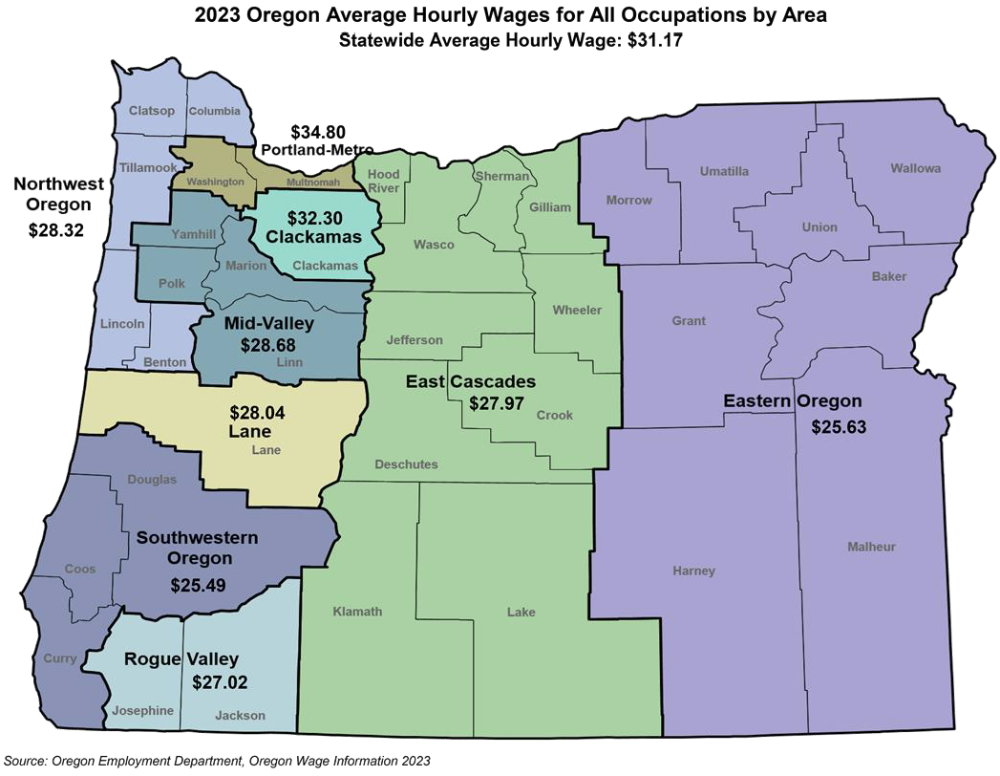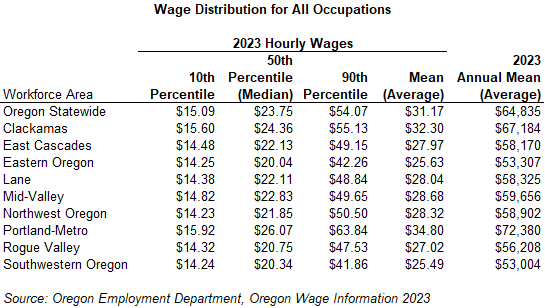2023 Oregon Wage Information
August 30, 2023Understanding how your take home pay compares with others in your field, or someone in a different career, is vitally important. It can inform you about how your work is being valued, and whether you may want to pursue more lucrative career options in the future. Likewise, hiring employers benefit from knowing the range of wages paid to workers in positions similar to those they are looking to hire, in their area of the state. Thanks to survey responses from employers around the state, the Oregon Employment Department publishes wage estimates for over 750 occupations, as well as hundreds of occupations in every region of the state. The 2023 version of Occupational Wage Information is now available.

The annual average wage for all occupations in Oregon was $64,835 in 2023, or $31.17 per hour. Of the occupations with published data, taxi drivers had the lowest average wage of $14.72 per hour. Obstetricians and gynecologists had the highest average wage ($159.43 per hour). Medical specialists like obstetricians and gynecologists have such a high average wage because it take many years of education and experience in order to perform that level of work.
The cost of living, mix of industries, and available workforce can be different across the state. We may see a higher number of software engineers and folks working in corporate headquarters in Portland, while natural resource jobs may be more concentrated in rural communities, and leisure and hospitality jobs focused near the coast. Wage estimates reflect these differences. The average hourly wage for Multnomah and Washington counties (the Portland-Metro region) was $34.80, and Clackamas County came in at $32.30 in 2023. Jobs in Eastern Oregon ($25.63) and Southwestern Oregon ($25.49) had lower average wages than jobs around the Portland tri-county area.

Looking at average wages is not enough to understand the whole story around the pay for different careers. Looking at average wages is a lot like trying to assemble a Lego® race car by looking at the box art. You can get a sense of the race car’s design and where some of the wheels go, but without looking at the pieces you are working with or the instructions you may have a hard time putting all the pieces together. Looking at wage ranges gives a more complete blueprint of how workers are paid when they start a career, or how that may change with more experience.
We provide wage ranges by publishing a series of percentiles for each occupation. A percentile wage shows the percentage of workers in an occupation that earn less than a given wage and the percentage that earn more. In most cases, wages in the 10th or 25th percentile likely reflect workers just entering a career, or who have less education attainment than others performing similar work. To better our understanding of wage ranges let’s look at the wages for some engineering occupations in Oregon.

Engineers make a career out of playing with Lego® blocks in the real world. Mechanical engineers can design the next generation of race cars. Engineering technicians may work with engineers to make sure new designs can be built and manufactured, while material engineers may work on what that new car will be made of. The wage ranges for these engineering careers typically show higher wages being paid to those positions with higher education requirements, and experience.
According to the U.S. Census, most engineering technicians in Oregon have some postsecondary education or an Associate’s degree. The majority of mechanical engineers have a Bachelor’s degree, while material engineers typically have some kind of advanced degree. With the wage range estimates we can see that most mechanical and material engineers are paid more than almost all mechanical engineering technicians or technologists.
Wages can also be different based on who is employing the engineer. According to estimates from the U.S. Bureau of Labor Statistics, mechanical engineers working for engineering firms providing scientific research and development services typically earn a higher entry-level 10th percentile wage ($37.71) than those employed by machinery manufacturers ($29.88), and transportation equipment manufacturers ($29.72). The median wage for all three industries is very similar, but engineering services do pay mechanical engineers in the 90th percentile a higher wage ($69.07) than the other two. This may indicate that these engineering firms may have a higher education requirement, or expect applicants to have more industry experience before applying.
Occupational wage information allows us to better understand what people get paid for the work they do, and how that may differ across the state. To get additional wage estimates for hundreds of careers please visit QualityInfo.org.